COTTONUSA:以“标准”的名义
- 格式:pdf
- 大小:610.02 KB
- 文档页数:1
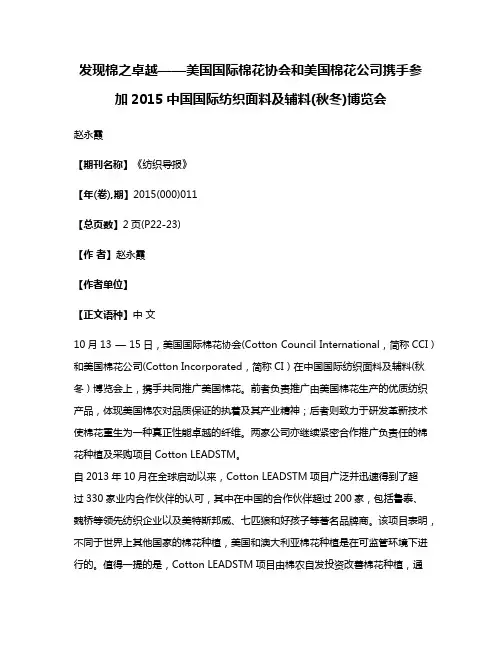
发现棉之卓越——美国国际棉花协会和美国棉花公司携手参加2015中国国际纺织面料及辅料(秋冬)博览会赵永霞【期刊名称】《纺织导报》【年(卷),期】2015(000)011【总页数】2页(P22-23)【作者】赵永霞【作者单位】【正文语种】中文10月13 — 15日,美国国际棉花协会(Cotton Council International,简称CCI)和美国棉花公司(Cotton Incorporated,简称CI)在中国国际纺织面料及辅料(秋冬)博览会上,携手共同推广美国棉花。
前者负责推广由美国棉花生产的优质纺织产品,体现美国棉农对品质保证的执着及其产业精神;后者则致力于研发革新技术使棉花重生为一种真正性能卓越的纤维。
两家公司亦继续紧密合作推广负责任的棉花种植及采购项目Cotton LEADSTM。
自2013年10月在全球启动以来,Cotton LEADSTM项目广泛并迅速得到了超过330家业内合作伙伴的认可,其中在中国的合作伙伴超过200家,包括鲁泰、魏桥等领先纺织企业以及美特斯邦威、七匹狼和好孩子等著名品牌商。
该项目表明,不同于世界上其他国家的棉花种植,美国和澳大利亚棉花种植是在可监管环境下进行的。
值得一提的是,Cotton LEADSTM项目由棉农自发投资改善棉花种植,通过真实、可评估的方式不断完善,无需供应链额外增加成本。
美国棉花公司高级副总裁Mark Messura先生在接受本刊记者采访时表示:“我们欢迎更多的纺纱厂、纺织和服装生产商、零售商及品牌商加入,因为该项目是解决所有人面临挑战的真正解决方案。
”根据美国棉花公司的调查,尽管中国运动服市场由化纤主导,但每3个中国消费者中就有2个表示他们很可能购买由天然纤维制成的运动服;如果棉制运动服可以吸湿、防紫外线、控温、防水,每4个中国消费者中就有3个以上愿意选择棉制运动服而不是化纤运动服,且大部分消费者愿意为这些棉制品的功能性创新支付更多。
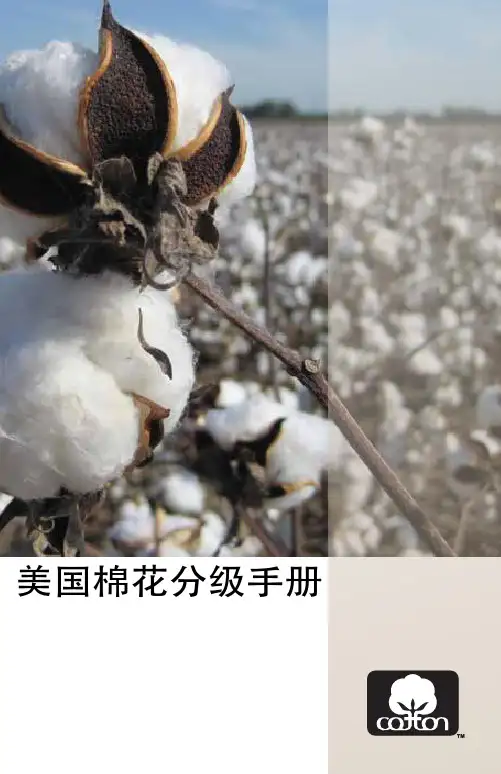
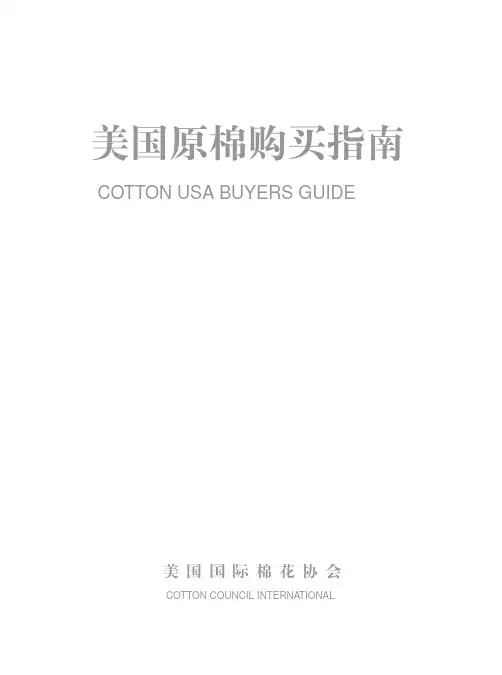
COTTON USA BUYERS GUIDECOTTON COUNCIL INTERNATIONAL( National Cotton Council of America ) (Cotton Council International) (Agricultural Market Service of the United States Department of Agriculture) (Cotton Incorporated)○ ○ ○ ○ ○ ○ ○ ○ ○ ○ ○ ○ ○ ○ ○ ○ ○ ○ ○ ○ ○ ○ ○ ○ ○ ○ ○ ○ ○ ○ ○Allen A.Terhaar1 2 3 4 5 6 7 8 12 14 20CCI(CCI) CCI CCICCICOTTON USACOTTON USA 50% COTTON USA CCI CCI CCI COTTON USA USA COTTON USA COTTON USA COTTONCCICOTTON USACOTTON USA COTTON USA CCI 30 COTTON USACOTTON USA124% 20% 1-1/1632%35% 1-3/3224% 30% 1-1/1620% 1-1/821996 S-7 51.3% 10% S-6 23.1%52.85 19961996/9748074,400 375,000 19,000 60,100 528,50042,000 164,000 1 4,000 36,000 256,000S-6 1-3/8 - 1-7/16 3.5 - 4.7 38 S-7 1-3/8 - 1-1/2 3.5 - 4.5 4131996/97 21%79%1996/97 80%20% (Modules) 1100(Trailers)28450499%1%1968495 22555 ( 1400 ) 21 ( 535 ) 28 ( 710 )58 ( 1473.2 ) 25 ( 635 ) 21 ( 535 )5( 1992/93-1994/95)Tampa, FL Charleston, SC Savannah, GA Other1.65% 1.31% 0.36% 0.67%Houston Galveston, TX New Orleans, LA Laredo, TX other7.13% 5.05% 8.53% 0.29% 2.23% 0.43%Los Angeles,CA San Francisco/ Oakland,CA Seattle,WA34.47% 15.91% 16.69%Detroit,MI other61981 ( HVI ) 1990 HVI1991 HVI(1) 1/100 1/32(2)100 1001/2(3)7(4)( G/T )1000(5)( Rd )( +b )Rd 41-3+b Rd 72 +b 9.08255(6)7() HVI9Good Middling Strict Middling Middling Strict Low Middling Low Middling Strict Good Ordinary Good Ordinary Good Middling Strict Middling Middling Strict Low Middling Low Middling Strict Good Ordinary Good Middling Strict Middling Middling Strict Low Middling Low Middling Strict Good Ordinary Strict Middling Middling Strict Low Middling Low Middling Strict Middling MiddlingGM SM Mid SLM LM SGO GO GM LtSp SM LtSp Mid LtSp SLM LtSp LM LtSp SGO LtSp GM Sp SM Sp Mid Sp SLM Sp LM Sp SGO Sp SM Tg Mid Tg SLM Tg LM Tg SM YS M YS11 21 31 41 51 61 71 12 22 32 42 52 62 13 23 33 43 53 63 24 34 44 54 25 35101 2 3 4 5 6 7LG 1 LG 2 LG 3 LG 4 LG 5 LG 6 LG 71 2 3 4 5 6 713/16 24 13/16 ............................................................................. 26 7/8 ................................................................................. 28 29/32 ............................................................................. 29 15/16 ............................................................................. 30 31/32 ............................................................................. 31 1 .................................................................................... 32 1-1/32 ............................................................................ 33 1-1/16 ............................................................................ 34 1-3/32 ............................................................................ 35 1-1/8 .............................................................................. 36 1-5/32............................................................................. 37 1-3/16............................................................................. 38 1-7/32............................................................................. 39 1-1/4............................................................................... 40 1-9/32............................................................................. 41 1-5/16............................................................................. 42 1-11/32........................................................................... 43 1-3/8............................................................................... 44 1-13/32........................................................................... 45 1-7/16............................................................................. 46 1-15/32........................................................................... 47 1-1/2............................................................................... 48111. 2. 3.123% 500(SJV)13(1) SM (2)(3)1.2.A3.R14(FOB) (FAS) (CNF) (CIF)CNF CIFCNF(FOBFAS)1516L/CLC17(1)(2)(3)(4)(5)18(6)19(ACSA)88 Union Center, Suite 1204, P.O.Box 3366 Memphis , Tennessee 38173 901-525-2272 901-527-8303 1924(AMCOT)P.O.Box 2827 Lubbock, Texas 79408 806-763-8011 806-762-7444 1971(NCPA)P.O.Box 172267 Memphis, Tennessee, 38187-2267 901-682-0800 901-682-2856 , ()201521 New Hampshire Avenue, NW Washington, DC 20036, U.S.A. 202-745-7805 202-483-4040 cottonusa@ cci-latinamerica@ P.O. Box 820285 Memphis, TN 38182, U.S.A.5 th Floor, Empire House 175 Piccadilly London WIV 9DB, United Kingdom 44-171-402-0029 44-171-724-8979 cci-london@1918 North Parkway Memphis, TN 38112, U.S.A. 1 901-274-9030 1 901-725-0510 info@ 20th Floor, Zoroastrian Building 101 Leighton Road Causeway Bay Hong Kong 852-2890-2755 852-2882-5463 cci-hongkong@Suite 303, Leema Building 146-1, Soosong-Dong, , Chongro- ku Seoul 110-140, Korea 82-2-722-3681/3 82-2-722-3684 cci-seoul@。
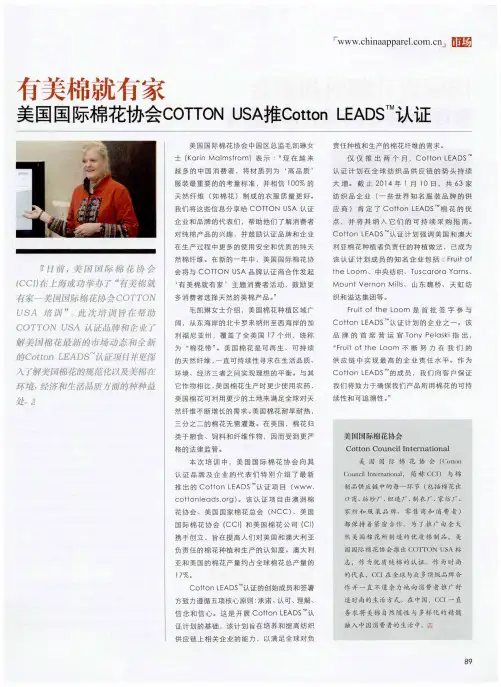
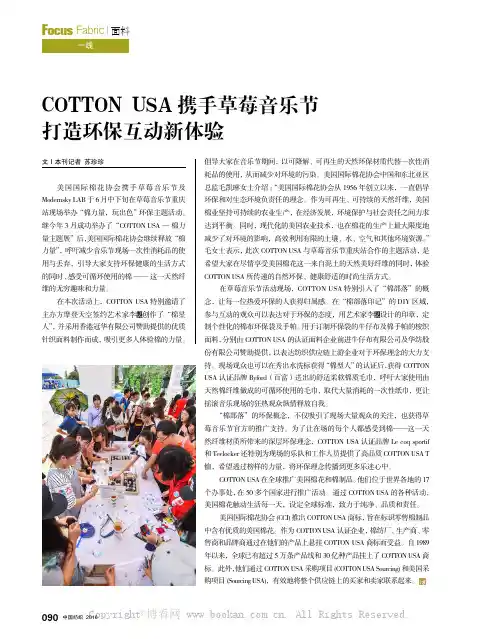
090 中国纺织 2016F ocus Fabric | 面料一线文|本刊记者 苏珍珍美国国际棉花协会携手草莓音乐节及Modernsky LAB 于6月中下旬在草莓音乐节重庆站现场举办 “棉力量,玩出色” 环保主题活动。
继今年3月成功举办了“COTTON USA — 棉力量主题展”后,美国国际棉花协会继续释放“棉力量”,呼吁减少音乐节现场一次性消耗品的使用与丢弃,引导大家支持环保健康的生活方式的同时, 感受可循环使用的棉 —— 这一天然纤维的无穷趣味和力量。
在本次活动上,COTTON USA 特别邀请了主办方摩登天空签约艺术家李创作了“棉星人”,并采用香港冠华有限公司赞助提供的优质针织面料制作而成,吸引更多人体验棉的力量。
COTTON»USA 携手草莓音乐节»打造环保互动新体验倡导大家在音乐节期间,以可降解、可再生的天然环保材质代替一次性消耗品的使用,从而减少对环境的污染。
美国国际棉花协会中国和东北亚区总监毛凯琳女士介绍:“美国国际棉花协会从1956年创立以来,一直倡导环保和对生态环境负责任的理念。
作为可再生、可持续的天然纤维,美国棉业坚持可持续的农业生产,在经济发展,环境保护与社会责任之间力求达到平衡。
同时,现代化的美国农业技术,也在棉花的生产上最大限度地减少了对环境的影响,高效利用有限的土壤、水、空气和其他环境资源。
”毛女士表示,此次COTTON USA 与草莓音乐节重庆站合作的主题活动,是希望大家在尽情享受美国棉花这一来自泥土的天然美好纤维的同时,体验COTTON USA 所传递的自然环保、健康舒适的时尚生活方式。
在草莓音乐节活动现场,COTTON USA 特别引入了“棉部落”的概念,让每一位热爱环保的人获得归属感。
在“棉部落印记”的DIY 区域,参与互动的观众可以表达对于环保的态度,用艺术家李设计的印章,定制个性化的棉布环保袋及手帕。
用于订制环保袋的牛仔布及棉手帕的梭织面料,分别由COTTON USA 的认证面料企业前进牛仔布有限公司及华纺股份有限公司赞助提供,以表达纺织供应链上游企业对于环保理念的大力支持。
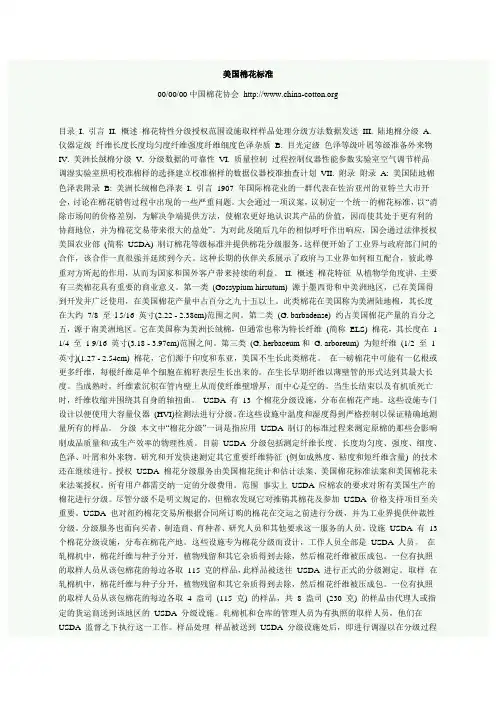
美国棉花标准00/00/00中国棉花协会目录I. 引言II. 概述棉花特性分级授权范围设施取样样品处理分级方法数据发送III. 陆地棉分级 A. 仪器定级纤维长度长度均匀度纤维强度纤维细度色泽杂质 B. 目光定级色泽等级叶屑等级准备外来物IV. 美洲长绒棉分级V. 分级数据的可靠性VI. 质量控制过程控制仪器性能参数实验室空气调节样品调湿实验室照明校准棉样的选择建立校准棉样的数据仪器校准抽查计划VII. 附录附录A: 美国陆地棉色泽表附录B: 美洲长绒棉色泽表I. 引言1907 年国际棉花业的一群代表在佐治亚州的亚特兰大市开会,讨论在棉花销售过程中出现的一些严重问题。
大会通过一项议案,议制定一个统一的棉花标准,以“消除市场间的价格差别,为解决争端提供方法,使棉农更好地认识其产品的价值,因而使其处于更有利的协商地位,并为棉花交易带来很大的益处”。
为对此及随后几年的相似呼吁作出响应,国会通过法律授权美国农业部(简称USDA) 制订棉花等级标准并提供棉花分级服务。
这样便开始了工业界与政府部门间的合作,该合作一直很强并延续到今天。
这种长期的伙伴关系展示了政府与工业界如何相互配合,彼此尊重对方所起的作用,从而为国家和国外客户带来持续的利益。
II. 概述棉花特征从植物学角度讲,主要有三类棉花具有重要的商业意义。
第一类(Gossypium hirsutum) 源于墨西哥和中美洲地区,已在美国得到开发并广泛使用,在美国棉花产量中占百分之九十五以上。
此类棉花在美国称为美洲陆地棉,其长度在大约7/8 至l 5/16 英寸(2.22 - 2.38cm)范围之间。
第二类(G. barbadense) 约占美国棉花产量的百分之五,源于南美洲地区。
它在美国称为美洲长绒棉,但通常也称为特长纤维(简称ELS) 棉花,其长度在 1 1/4 至1 9/16 英寸(3.18 - 3.97cm)范围之间。
第三类(G. herbaceum和G. arboreum) 为短纤维(1/2 至1 英寸)(1.27 - 2.54cm) 棉花,它们源于印度和东亚,美国不生长此类棉花。
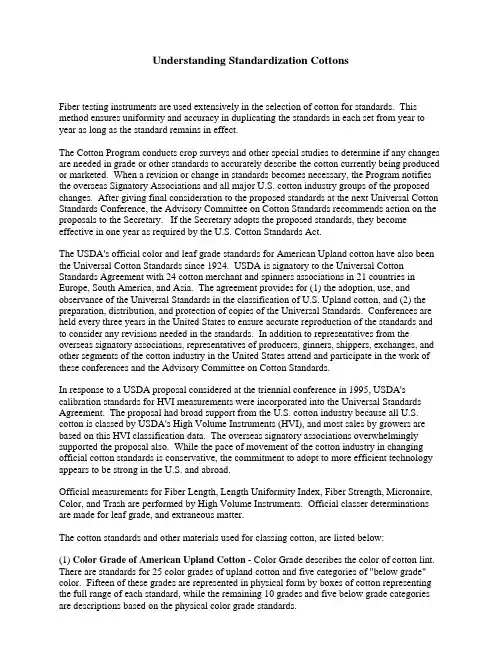
Understanding Standardization CottonsFiber testing instruments are used extensively in the selection of cotton for standards. This method ensures uniformity and accuracy in duplicating the standards in each set from year to year as long as the standard remains in effect.The Cotton Program conducts crop surveys and other special studies to determine if any changes are needed in grade or other standards to accurately describe the cotton currently being produced or marketed. When a revision or change in standards becomes necessary, the Program notifies the overseas Signatory Associations and all major U.S. cotton industry groups of the proposed changes. After giving final consideration to the proposed standards at the next Universal Cotton Standards Conference, the Advisory Committee on Cotton Standards recommends action on the proposals to the Secretary. If the Secretary adopts the proposed standards, they become effective in one year as required by the U.S. Cotton Standards Act.The USDA's official color and leaf grade standards for American Upland cotton have also been the Universal Cotton Standards since 1924. USDA is signatory to the Universal Cotton Standards Agreement with 24 cotton merchant and spinners associations in 21 countries in Europe, South America, and Asia. The agreement provides for (1) the adoption, use, and observance of the Universal Standards in the classification of U.S. Upland cotton, and (2) the preparation, distribution, and protection of copies of the Universal Standards. Conferences are held every three years in the United States to ensure accurate reproduction of the standards and to consider any revisions needed in the standards. In addition to representatives from the overseas signatory associations, representatives of producers, ginners, shippers, exchanges, and other segments of the cotton industry in the United States attend and participate in the work of these conferences and the Advisory Committee on Cotton Standards.In response to a USDA proposal considered at the triennial conference in 1995, USDA's calibration standards for HVI measurements were incorporated into the Universal Standards Agreement. The proposal had broad support from the U.S. cotton industry because all U.S. cotton is classed by USDA's High Volume Instruments (HVI), and most sales by growers are based on this HVI classification data. The overseas signatory associations overwhelmingly supported the proposal also. While the pace of movement of the cotton industry in changing official cotton standards is conservative, the commitment to adopt to more efficient technology appears to be strong in the U.S. and abroad.Official measurements for Fiber Length, Length Uniformity Index, Fiber Strength, Micronaire, Color, and Trash are performed by High Volume Instruments. Official classer determinations are made for leaf grade, and extraneous matter.The cotton standards and other materials used for classing cotton, are listed below:(1) Color Grade of American Upland Cotton - Color Grade describes the color of cotton lint. There are standards for 25 color grades of upland cotton and five categories of "below grade" color. Fifteen of these grades are represented in physical form by boxes of cotton representing the full range of each standard, while the remaining 10 grades and five below grade categories are descriptions based on the physical color grade standards.(2) Leaf Grade of American Upland Cotton - Leaf grade describes the leaf or trash content in the cotton. There are seven leaf grades designated as leaf grade A1" through A7" , and all are represented by physical standards. In addition, there is a descriptive Abelow grade@ (leaf grade 8) designation.The current reserve set of the Universal Standards for Color and Leaf Grades of American Upland Cotton is sealed and deposited in a vault in Memphis, TN. Copies of these standards, containing six samples or biscuits, known as practical forms, are prepared and sold for $125f.o.b. Memphis, or $130 domestic delivery. The utmost care is taken to keep the range of color and leaf in all copies of each grade standard as nearly the same as possible. The standards for the seven White color grades contain the leaf content of the respective leaf grades. For example, the standard for Good Middling White (11) color contains the standard leaf content for Leaf Grade "l" and the standard for Low Middling White contains the standard leaf content of Leaf Grade "5".The color of cotton deepens with age more in the high grades than in the low grades. The color of the cotton in the standards may differ considerably as time goes by, especially when the standards are stored under extreme conditions of temperature and/or relative humidity. Because of this natural propensity for change, copies of the grade standards must be freshly prepared annually and are effective for one year beginning each July 1.(3) Grades of American Pima Cotton - There are six official grades (Grades A1" through A6") for American Pima cotton, all represented by physical standards. In addition, there is a descriptive "below grade" designation. Copies of the American Pima Grade Standards are sold for $160 f.o.b. Memphis, or $165, surface delivery.(4) Fiber Length, Length Uniformity Index, and Fiber Strength - The Cotton Program uses High Volume Instruments for the classification of all Upland and American Pima cotton. There are Universal HVI Calibration Standards for American Upland cotton for calibrating length, length uniformity index, and strength. The present official standards for fiber or staple length provide for various lengths in terms of inches and fractions of an inch ranging from 13/16 inches upward, generally in graduations of one thirty-seconds of an inch. The upper half mean length of fiber is measured by the HVI system in hundredths of an inch and length is converted to thirty-seconds of an inch. Length uniformity index is the ratio between the mean length and the upper half mean length expressed as a percentage. Fiber strength is measured in grams per tex and represents the force in grams to break a bundle of fibers one tex unit in size. Both the Universal HVI Calibration Standards for Upland cotton and the USDA HVI Calibration Cottons for American Pima cotton are available, in 5-pound boxes, for $95 f.o.b. Memphis, TN or $100 domestic delivery. Two such cottons, which span a range in length and strength, are required for instrument calibration.(5) Micronaire - Official cotton standards for micronaire or fiber fineness and maturity are described as the measure of such qualities provided by air flow instrument tests in terms of micronaire readings in accordance with established procedures. These procedures include descriptions of approved weighing and testing equipment and standard operating instructions for the equipment. Mike readings are expressed in units to the nearest one tenth, (e.g. 3.1, 3.2, 3.3, 3.4); however, common practice within the industry is to drop the decimal point when reporting "mike" readings (e.g. 31, 32, 33, 34). Mike readings of American Upland cotton range from 2.4 to 6.0. About 75 percent of the cotton crop falls in the 3.5 to 4.9 range.The Cotton Program participates and manages the International Calibration Cotton Standards (ICCS) Program which, under the guidance of the ICCS Committee, establishes standard valuesfor International Calibration Cottons. Currently, there are six International Calibration Cotton Standards for Micronaire Only that span the range of micronaire scale from 2.6 to 5.5. The price for a 1-pound roll of the micronaire-only calibration cotton standards is $28 f.o.b. Memphis, or $31 domestic delivery. This price also includes the cost of a semiannual check test program which aids in achieving a common test level on a global basis. Each laboratory that purchases calibration cottons receives two samples for check tests each six-month period, and upon return of data, receives a report on its results compared to other participants. These standards have been purchased by more than 500 laboratories worldwide, and about 250 of the laboratories participated in the most recent semiannual check test. In addition to the semiannual check test, a quarterly check test for micronaire equipment is available to overseas arbitration laboratories. This program, which ensures a common level of test results, is available for a fee of $21 per quarter per laboratory.(6) Trash - The trash measurement is made by the HVI video trashmeter which measures the percentage area and particle count of trash on the sample's surface. A trashmeter calibration tile and cotton trash level samples, mounted under glass, are available for calibration and verification of the trash measurements. The cost of the trash tile is $30 f.o.b. Memphis, TN or $33 domestic delivery. The cost of the trash level samples is $40 f.o.b. Memphis, TN ($240 for full set of six) or $44 domestic delivery ($264 for full set of six). The range of trash levels usually encountered is included in a set of six samples.(7) Color - The HVI colormeter measures reflectance (Rd) and yellowness (+b). The Rd indicates the sample's degree of grayness and +b indicates how much yellow color is in the sample. Ceramic color calibration tiles for the HVI colormeter are distributed by the Cotton Program. The cost for a five tile set is $125 f.o.b. Memphis, TN or $130 domestic delivery. (8) Other Standards - There are also Universal Standards for descriptions of laboratory atmospheric conditions and conditioning practices and procedures. In addition, a brochure entitled "Guidelines for HVI Testing" has been prepared that contains standardized procedures for HVI testing which will enable users of HVI systems to achieve a common test results level for each measured property.Programs for Checking HVI Measurements - An HVI Check Test Program is conducted to ensure a standard level of testing. Two samples are sent to participants each month for testing. The returned data are summarized and each participant receives a report comparing their results to established values for the samples. The annual cost of the HVI check test program is $168 domestic and $324 overseas. An HVI Level Assessment Program was initiated in 1993 in response to the worldwide proliferation in the use of HVI measurements in trading Upland cotton in the world markets. Participants submit check samples that have been tested by HVI for retesting by the Quality Assurance Unit in much the same manner as the Cotton Programs internal supervisory procedures. The participant receives a report showing how well the results of the two tests compare. This program has been beneficial in achieving a common test level worldwide. Cost for this program is $4 per sample in lots of 10 samples.Summary - USDA's cotton standards are used almost exclusively within the U.S. and are broadly accepted in the foreign marketing of Upland-type cotton, especially that grown in the United States. The standards provide a sound base for establishing market values that gain more acceptance with each year's crop. International trading disputes are settled by utilizing U.S. standards. The check test programs contribute to the growing confidence in USDA's cotton standards and also ensure a common level of test results for all users.。
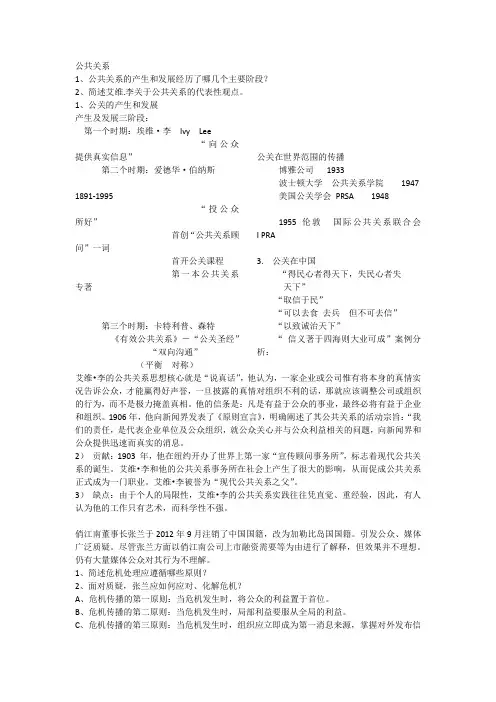
公共关系1、公共关系的产生和发展经历了哪几个主要阶段?2、简述艾维.李关于公共关系的代表性观点。
1、公关的产生和发展产生及发展三阶段:第一个时期:埃维·李Ivy Lee“向公众提供真实信息”第二个时期:爱德华·伯纳斯1891-1995“投公众所好”首创“公共关系顾问”一词首开公关课程第一本公共关系专著第三个时期:卡特利普、森特《有效公共关系》-“公关圣经”“双向沟通”(平衡对称)公关在世界范围的传播博雅公司1933波士顿大学公共关系学院1947美国公关学会PRSA 19481955 伦敦国际公共关系联合会I PRA3. 公关在中国“得民心者得天下,失民心者失天下”“取信于民”“可以去食去兵但不可去信”“以致诚治天下”“信义著于四海则大业可成”案例分析:艾维•李的公共关系思想核心就是“说真话”,他认为,一家企业或公司惟有将本身的真情实况告诉公众,才能赢得好声誉,一旦披露的真情对组织不利的话,那就应该调整公司或组织的行为,而不是极力掩盖真相。
他的信条是:凡是有益于公众的事业,最终必将有益于企业和组织。
1906年,他向新闻界发表了《原则宣言》,明确阐述了其公共关系的活动宗旨:“我们的责任,是代表企业单位及公众组织,就公众关心并与公众利益相关的问题,向新闻界和公众提供迅速而真实的消息。
2)贡献:1903 年,他在纽约开办了世界上第一家“宣传顾问事务所”,标志着现代公共关系的诞生。
艾维•李和他的公共关系事务所在社会上产生了很大的影响,从而促成公共关系正式成为一门职业。
艾维•李被誉为“现代公共关系之父”。
3)缺点:由于个人的局限性,艾维•李的公共关系实践往往凭直觉、重经验,因此,有人认为他的工作只有艺术,而科学性不强。
俏江南董事长张兰于2012年9月注销了中国国籍,改为加勒比岛国国籍。
引发公众、媒体广泛质疑。
尽管张兰方面以俏江南公司上市融资需要等为由进行了解释,但效果并不理想。
仍有大量媒体公众对其行为不理解。
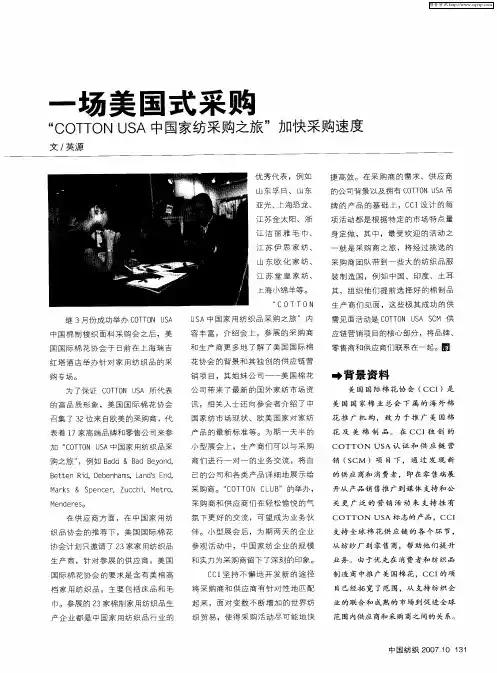
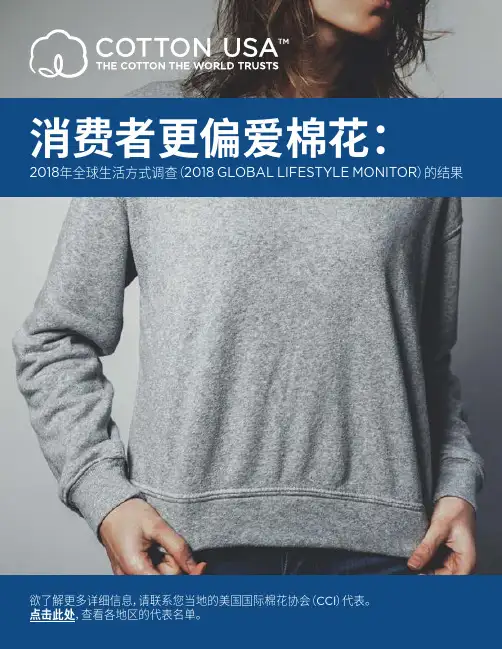
消费者更偏爱棉花:2018年全球生活方式调查(2018GLOBAL LIFESTYLE MONITOR)的结果
由国际市场研究公司益普索(Ipsos)进行的2018年全球生活方式调查的结果显示,服装中使用的纤维类型对消费者的购买决定有着重大的影响。
事实上,86%的受访者表示会查看服装吊牌上的纤维含量。
在2018年1月/2月对全球十大消费市场(中国、哥伦比亚、德国、印度、意大利、日本、墨西哥、泰国、土耳其和英国)的10,000多名消费者进行的研究中,81%的人更喜欢棉制服装。
这项研究的结果表明,消费者不仅会花时间研究服装中使用的纤维类型,而且更偏爱棉制品。
在各类服装中都存在这种情况,86%的消费者更喜欢棉制牛仔裤,76%的消费者更喜欢棉制T恤,71%的消费者更喜欢棉制睡衣,62%的消费者更喜欢棉制裤子,58%的消费者更喜欢棉制衬衫。
那么,为什么消费者更偏爱棉花呢?全球生活方式调查的结果表明,消费者对棉花的看法与他们想要的服装性能特征一致。
消费者在购买服装时最看重的特征是舒适性(83%),这也是消费者最有可能与棉花相关联的特征(69%)。
这些纤维对环境的安全性如何?
美国国际棉花协会是一
个执行平等就业机会的雇主。
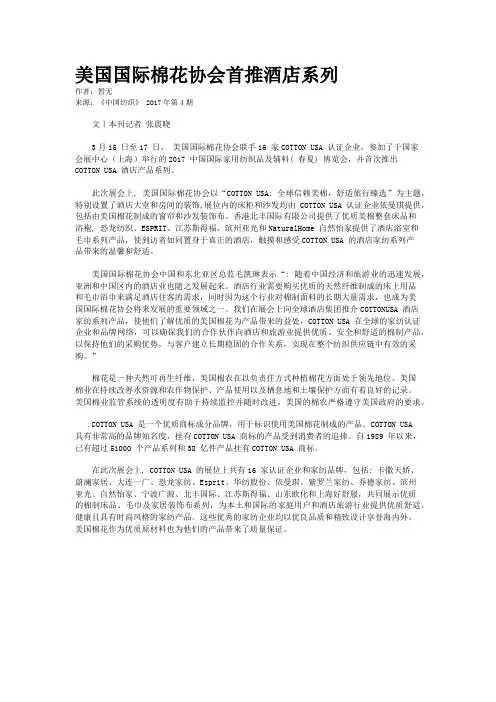
美国国际棉花协会首推酒店系列作者:暂无来源:《中国纺织》 2017年第4期文|本刊记者张震晓3月15 日至17 日,美国国际棉花协会联手16 家COTTON USA 认证企业,参加了于国家会展中心(上海)举行的2017 中国国际家用纺织品及辅料( 春夏) 博览会,并首次推出COTTON USA 酒店产品系列。
此次展会上, 美国国际棉花协会以“COTTON USA: 全球信赖美棉,舒适旅行臻选”为主题,特别设置了酒店大堂和房间的装饰,展位内的床柜和沙发均由COTTON USA 认证企业依曼琪提供,包括由美国棉花制成的窗帘和沙发装饰布。
香港北丰国际有限公司提供了优质美棉整套床品和浴袍, 恐龙纺织、ESPRIT、江苏斯得福、滨州亚光和NaturalHome 自然怡家提供了酒店浴室和毛巾系列产品,使到访者如同置身于真正的酒店,触摸和感受COTTON USA 的酒店家纺系列产品带来的温馨和舒适。
美国国际棉花协会中国和东北亚区总监毛凯琳表示“: 随着中国经济和旅游业的迅速发展,亚洲和中国区内的酒店业也随之发展起来。
酒店行业需要购买优质的天然纤维制成的床上用品和毛巾浴巾来满足酒店住客的需求,同时因为这个行业对棉制面料的长期大量需求,也成为美国国际棉花协会将来发展的重要领域之一。
我们在展会上向全球酒店集团推介COTTONUSA 酒店家纺系列产品,使他们了解优质的美国棉花为产品带来的益处,COTTON USA 在全球的家纺认证企业和品牌网络,可以确保我们的合作伙伴向酒店和旅游业提供优质、安全和舒适的棉制产品,以保持他们的采购优势,与客户建立长期稳固的合作关系,实现在整个纺织供应链中有效的采购。
”棉花是一种天然可再生纤维,美国棉农在以负责任方式种植棉花方面处于领先地位。
美国棉业在持续改善水资源和农作物保护、产品使用以及栖息地和土壤保护方面有着良好的记录。
美国棉业监管系统的透明度有助于持续监控并随时改进,美国的棉农严格遵守美国政府的要求。
探索“棉”的无限可能作者:暂无来源:《中国纺织》 2016年第4期文本刊记者苏珍珍美国国际棉花协会近日携手梅赛德斯-奔驰中国国际时装周,于2016/2017秋冬系列发布会期间,在751D·PARK北京时尚设计广场时尚回廊举办为期一周的“COTTON USA - 棉力量主题展”,让潮流爱好者直接参与到国内顶级时装专业盛会,激发消费者对天然优质的棉纤维的创意灵感,探索“棉”的无限可能,倡导时尚的生活方式。
中国棉花协会秘书长王建红先生出席了此次活动。
COTTON USA - 棉力量主题展分为“独立设计区”和“潮流发布区”两个主要区域,分别展示由设计师、艺术家以“棉”为主题设计并制作的先锋艺术,以及COTTON USA 的认证品牌带来的时尚棉潮流展示。
美国国际棉花协会中国和东北亚区总监毛凯琳女士表示:“作为中国国际时装周的官方活动之一,‘COTTON USA -棉力量主题展’是一次充满时尚创造力的盛会,希望藉由时装周这样时尚的专业盛会,通过高品质的美国棉花,向更多大众消费者传递自然环保、健康舒适的时尚生活方式。
”独立设计区,用创意探索棉质生活在主题展的“独立设计区”,五位设计师及艺术家以“棉”为题,带来不凡的艺术演绎。
服装设计师苏仁莉以棉的纯白色调为基础,通过面料的解构和重组,表现女性自由与独立的张力。
服装设计师韩东洋以冲撞的色彩,将棉的“自由呼吸”的抽象形态呈现在观众眼前。
她在谈到与棉的“不解之缘”时提到,“艺术来源于生活的点滴,而棉也是生活中无处不在,两者紧紧相依,互补互存。
我希望观众能够在我和美国国际棉花协会合作的作品中,感受一次棉的艺术力量。
”除了色彩和纯白色碰撞的视觉盛宴,设计师张娜和ARTPLUS ×雕塑艺术家匡峻用作品带来过去与未来的对话。
张娜的“再造衣银行”用包含历史和时间记忆的三条长裤、两条短裤的旧衣服,重新设计成为一件新衣作品,引起大家对环保与再造的思考。
而ARTPLUS × 雕塑艺术家匡峻,与情商研究专家张怡筠博士设计的亲子互动治愈玩具——“无理取闹”,用暖心的造型向孩子传递全天候的爱。
COTTON USA:以“标准”的名义张兴军【期刊名称】《中国经济信息》【年(卷),期】2017(000)011【总页数】1页(P76)【作者】张兴军【作者单位】【正文语种】中文COTTON USA希望通过一场以旅行与标准、信赖与选择的探讨,使其成为注重可持续发展、承担环保责任、确保产品安全、关注公正劳资关系的品牌与零售商的供应之选,借此引领行业变革与进步,打造一个有更好生活体验的世界。
2017年5月15日,美国国际棉花协会(CCI)首次在中国举办CHINA COTTON DAY,就“全球信赖美棉,舒适旅行甄选”主题展开对当前中国旅游饭店业可持续发展的行业探讨。
这场专业对话,还邀请了美国国际棉花协会代表以及中国旅游饭店业协会(CTHA)酒店代表共同参与,深度解读对“舒适旅行”的理解与思考。
首届“CHINA COTTON DAY”特别设置了行业座谈、迷你展厅以及主题活动等环节,将活动举办地北京怡亨酒店的两间套房变身为展厅。
来自14家COTTON USA认证企业的床品系列与浴室毛巾等产品,在展厅中巧妙地与酒店布置融为一体,展现了美国棉花在酒店用品上的应用及其带来的卓越品质与成本节约的优势。
由此激发到场的来自中国旅游饭店业协会的32位酒店代表,与美棉共同探讨酒店的可持续发展议题。
适逢美国国际棉花协会正在全球范围内推广“COTTON USA:全球信赖美棉”全新品牌理念,而由6家知名认证品牌BIB、百富(Byford)、Devil Nut、靛堂(Indigo Tank)、江南布衣(JNBY)、乐卡克(le coq sportif)等联合呈现的时装秀更是完美展示了在旅行途中所带来的舒适体验。
在过去十年中,中国的旅游业快速发展,推动全国乃至亚洲的饭店业持续繁荣。
“我们发现,全世界的饭店业品牌都在竭力为客人提供宾至如归的舒适体验,其中的一个重要环节就是在客房中确保提供天然、健康的纺织用品。
”美国国际棉花协会执行总裁Bruce AtherleyBruce Atherley表示,“美国国际棉花协会的工作,就是让美国棉花成为那些注重可持续发展、承担环保责任、确保产品安全、关注公正劳资关系的品牌与零售商的供应之选。
COTTON USA质量大会在上海召开赵永霞【期刊名称】《纺织导报》【年(卷),期】2016(000)011【总页数】1页(P29-29)【作者】赵永霞【作者单位】【正文语种】中文美国国际棉花协会(Cotton Council International,简称CCI)于10月10日在中国上海召开“COTTON USA 质量大会”,推广在生产优质纺织品中主要使用的美国棉花和棉纱的原材料。
来自美国和中国棉纺行业的80余位代表参加了会议,并且探讨了优质和稳定的原材料供应对于生产企业的重要性。
中国是全世界最大的纺织品生产国,2015年的用棉量达到3 500万包,而去年全年进口的棉纱量相等于900万包棉花。
美国国际棉花协会的主席Keith Lucas表示:“COTTON USA 质量大会为我们提供了一个独特的平台来特别强调美国棉花的品质。
责任和创新,同时也为中国的大型棉纺厂和生产企业提供了一个交流和对话的机会。
这是一个非常有建设性的会议,使我们能和一些使用美国棉花的大客户直接交流,了解他们的需求,并且探讨美国棉业如何帮助企业面对生产中的各项挑战以保持质量标准。
我们希望在将来可以和这些企业共同合作,为使用美国棉花的纺织企业带来效益。
”会上,中国纺织工业联合会副会长孙淮滨、美国棉花公司高级经济师Jon Devine、美国棉业总会美国棉花种植者协会主席Mike Tate、定制技术解决方案主席Roger E. Insley、Tri Blend Consulting公司总经理Roger Gilmartin等特邀嘉宾分别围绕中国纺织行业实施“三品战略”的背景和途径、全球棉花经济展望、美国棉花纤维质量情况、棉花纤维质量对纺纱厂效益的影响以及棉纱质量对面料生产过程中的技术和效益影响等主题发表了精彩演讲。
在下午的专题讨论环节,无锡第一棉纺厂总经理周晔君、天虹纺织集团有限公司棉花业务部总经理陈夏驰、佛山致兴纺织服装有限公司董事副总经理杨斌和江门大兴针织公司董事副总经理舒宗华围绕“优秀的品牌始于纤维品质”展开探讨。
中美棉花质量标准异同分析1 关于标准的性质中美两国的棉花标准,都是由国家颁布的强制性标准,在各自的全国范围内、在棉花贸易相关的各个行业中,都必须严格执行。
2 关于标准的作用中美两国的棉花标准,在各自的棉花生产、流通、贸易中都起着十分重要的作用,主要表现在以下几个方面:一是客观地对棉花质量进行评定,维护贸易各方的正当利益;二是不断地促进棉花质量的提高,增强棉花及其制品的市场竞争力;三是促进棉花行业技术进步、产业升级,推动棉业的健康发展;四是为国家实施对棉花市场的监管和宏观调控提供重要的技术依据-- 作者:dhr-- 发布时间:2007-09-26 00:00:00.0-- 中美棉花质量标准异同分析(续)3 关于标准的管理在棉花标准化的管理工作中,中美两国有着一些重要的相同方面:一是棉花标准化工作都由国家高度统一管理。
为了切实贯彻执行国家强制性标准,中美两国都建立了完整的、独立的工作机构。
美国由农业部农产品营销服务局主管,即由USDA的AMS主管;我国由国家质检总局直属的中国纤维检验局主管,即由AQSIQ的CFIB主管。
两国都各自建立了健全的机构体系。
美国在产棉州设有12个棉花分级实验室,分布于其产棉带;我国共设有170余个省(区)、市、地、县纤检机构。
二是棉花标准化工作都是依法授权履行管理职能。
美国农业部的官方检测机构是依据《美国棉花统计和评估法》、《美国棉花标准法》和《美国棉花期货法》授权,按照棉花标准从事棉花分级活动;我国专业纤检机构是依据《棉花质量监督管理条例》对棉花标准的实施情况进行监督检查和按照棉花标准对棉花质量实行公证检验。
三是棉花标准化工作都形成了一套比较合理、行之有效的管理方法和制度。
例如,棉花文字标准的制修订,凡是涉棉各方都要广泛参与,并需经协调一致后方可报批、审定、发布实施;实物标准的研复制工作也都是由主管部门负责,组织集中制作、专家审查、行政批准、统一销售使用;对分级检验人员都要经过技术培训,考试合格,我国还实行了棉花质量检验师执业资格制度;对各自实行的官方检验工作质量都实行严格的监控,进行经常性的监督抽验;此外,对贸易各方对官方检验结果的异议提供了复检救济制度。